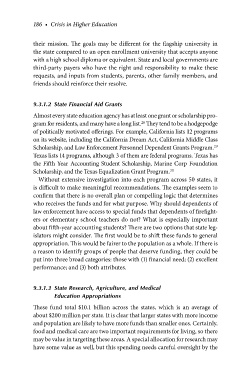Page 215 - Crisis in Higher Education
P. 215
186 • Crisis in Higher Education
their mission. The goals may be different for the flagship university in
the state compared to an open enrollment university that accepts anyone
with a high school diploma or equivalent. State and local governments are
third-party payers who have the right and responsibility to make these
requests, and inputs from students, parents, other family members, and
friends should reinforce their resolve.
9.3.1.2 State Financial Aid Grants
Almost every state education agency has at least one grant or scholarship pro-
gram for residents, and many have a long list. They tend to be a hodgepodge
28
of politically motivated offerings. For example, California lists 12 programs
on its website, including the California Dream Act, California Middle Class
Scholarship, and Law Enforcement Personnel Dependent Grants Program.
29
Texas lists 14 programs, although 3 of them are federal programs. Texas has
the Fifth Year Accounting Student Scholarship, Marine Corp Foundation
Scholarship, and the Texas Equalization Grant Program. 30
Without extensive investigation into each program across 50 states, it
is difficult to make meaningful recommendations. The examples seem to
confirm that there is no overall plan or compelling logic that determines
who receives the funds and for what purpose. Why should dependents of
law enforcement have access to special funds that dependents of firefight-
ers or elementary school teachers do not? What is especially important
about fifth-year accounting students? There are two options that state leg-
islators might consider. The first would be to shift these funds to general
appropriation. This would be fairer to the population as a whole. If there is
a reason to identify groups of people that deserve funding, they could be
put into three broad categories: those with (1) financial need; (2) excellent
performance; and (3) both attributes.
9.3.1.3 State Research, Agriculture, and Medical
Education Appropriations
These fund total $10.1 billion across the states, which is an average of
about $200 million per state. It is clear that larger states with more income
and population are likely to have more funds than smaller ones. Certainly,
food and medical care are two important requirements for living, so there
may be value in targeting these areas. A special allocation for research may
have some value as well, but this spending needs careful oversight by the

